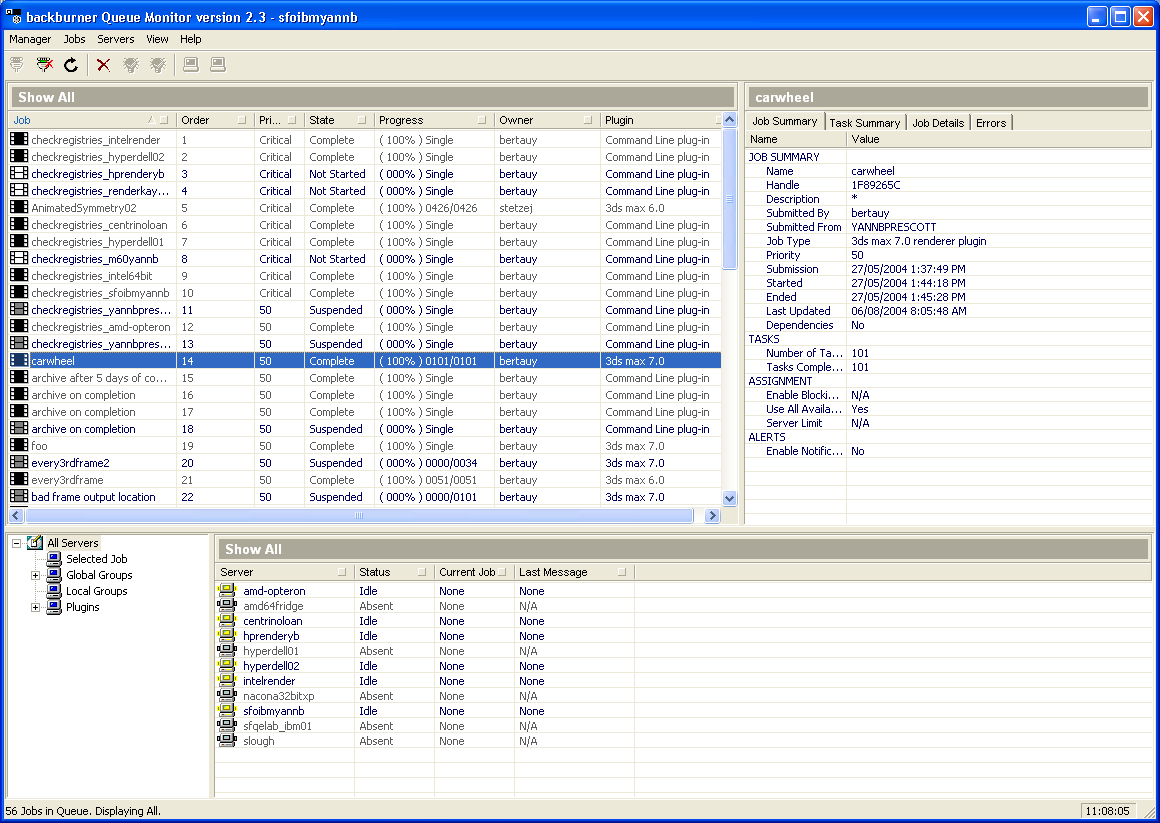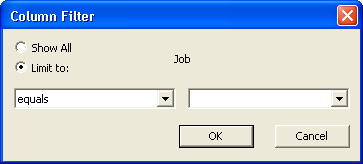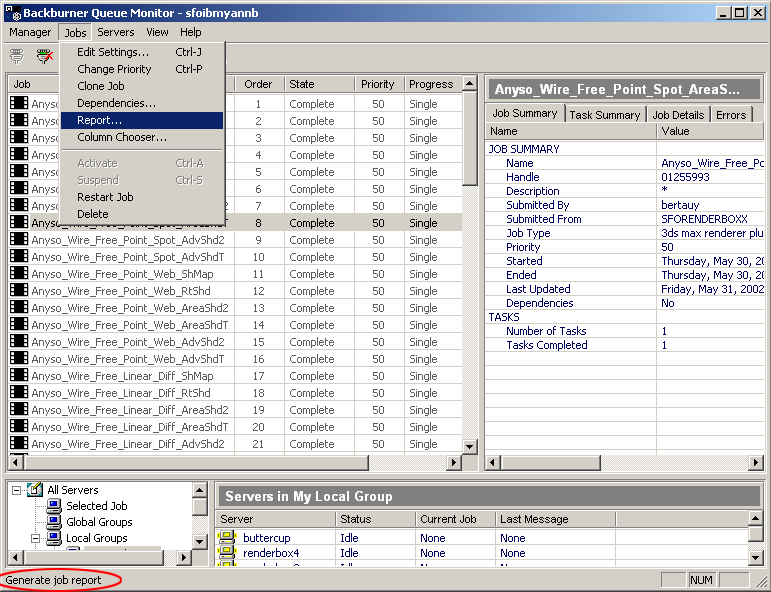![]()
Queue Monitor helps you adapt to changing needs and priorities. Jobs can be activated, deactivated, reordered, and removed, and servers can be unassigned to free up resources on workstations, or brought back online as they become available again.
You can run Queue Monitor from any computer connected to the rendering network. Once started, you can connect to any available network Manager. You can launch as many Queue Monitors as you want from anywhere on your network and connect to a Manager machine. All except the first Queue Monitor connecting to the Manager appear in "read only" mode. If there is already a Queue Monitor connected to the Manager, subsequent connections alert you that you are in read-only mode, and "Read Only" appears in the title bar. In read-only mode, you can view network render activity, but cannot change anything in the queue unless you obtain queue control.
To view all current jobs in the rendering queue, you first connect to the Manager that all of the servers are "talking to." To do this, you can either connect automatically to the Manager by searching with a subnet mask, or connect to a specific Manager by supplying the IP address or machine name of the machine where you started the Manager.
Procedures
To view all current jobs in the rendering queue:
- On the Queue Monitor toolbar, click
 (Connect).
(Connect). The Connect To Manager dialog appears.
- After you connect to a Manager once, the dialog remembers the Manager information and you can just click OK to connect to the same Manager.
If this is the first time you're connecting, or you're connecting to a different Manager, and you're using Automatic Search, just click OK. If you're not using Automatic Search, you need to specify the Manager to connect to. In the text field, enter the name or IP address of a network Manager. This is the same information you specified in the Server General Properties dialog.
- Click OK.
The Queue Monitor connects to the network Manager and activates its various display windows.
To suspend a job:
- Select one or more active or pending jobs in the Job list.
- Do one of the following:
- On the toolbar, click
 (Suspend).
(Suspend). - Choose Suspend from the Jobs menu.
- Right-click a highlighted job name in the Job list to display a pop-up menu, and then choose Suspend.
If necessary, use
 (Refresh) to view the new queue status.
(Refresh) to view the new queue status.
- On the toolbar, click
As requirements change, you can temporarily deactivate an active or pending job in the rendering queue, or reverse the process and restart jobs that are inactive.
When you suspend a job, the Servers assigned to the job either drop the frame they are rendering or finish writing the frame, depending on where they are in the rendering process. The next pending job becomes active and begins to render.
To activate a suspended job:
- Select the suspended job (denoted by a gray movie-frame icon).
 The Activate button on the toolbar becomes active.
The Activate button on the toolbar becomes active. - Click
 (Activate), or use the menu bar or right-click menu.
(Activate), or use the menu bar or right-click menu. The job becomes either Started or pending in the queue (Active), depending on whether or not another job is currently rendering.
Interface

The Queue Monitor user interface comprises a menu bar, a toolbar, a status display, and four windows: job list, job information, server tree view (or hierarchical list), and server list.
Menu bar
The menu bar includes these menus and functions:
Manager menu
Use to control aspects of the Queue Monitor and the network Manager.
- Connect
-
Connects to a Manager using the Connect To Manager dialog. In the dialog, turn on Auto Search to search for a Manager using the specified subnet mask, or turn off Auto Search to search for a Manager using a specific Manager name or IP address. Click OK to perform the search, or Cancel to exit without connecting.
If the Manager is found, current Servers and jobs appear in their respective lists in the Queue Monitor. If the Manager cannot be found, an alert appears.
- Disconnect
-
Disconnects from the current Manager. Available only after a connection is made.
- Auto-Connect
-
When this switch is turned on, you can automatically connect to a manager without the Connect To Manager dialog appearing. Whatever setting have been made in the Connect To Manager dialog will be used.
- Request Queue Control
-
Lets you gain control over the rendering queue. Available only when Queue Monitor is running on two or more machines in the network, and your copy was not the first one run.
When you request queue control, a dialog appears on the controlling machine informing that user of the request. The dialog counts down 10 seconds, and if no response is made during that time, or the OK button is clicked, control transfers to the requesting Queue Monitor, which then informs the requestor of the transfer. If the request is denied, the requesting user is informed of that fact.
- Request Client List
-
Displays a dialog listing the rendering servers on the network, and showing which is the controller (i.e., the active Queue Monitor) and the user name. Use this to determine which server is currently controlling the queue.
- Auto-Refresh
-
When on, Queue Monitor automatically updates the information in its windows every 20 seconds, or whenever information changes if information changes less frequently. When off, to update the windows you must click the toolbar Refresh button. Default=on.
Unless you are the only person managing the queue, we recommend leaving Auto-Refresh on. The danger of turning it off is the possibility of getting out of sync with the state of the queue. For instance, if another person deletes a job and you decide to edit that job, when you finish editing that job, the Manager will send you an error message saying the job no longer exists.
- Module Info Report
-
Choosing this command opens the Module Info Report dialog. For troubleshooting purposes, this command lets you generate a delimited file that shows you the version and location of Backburner plug-ins and the Backburner application itself for each network rendering system.
- Properties
-
Opens a window that displays information about the current setup of the machine that is running the network Manager, including job and server statistics, the Manager's system configuration, and TCP/IP statistics.
- Exit
-
Quits the Queue Monitor program.
Jobs menu
Use to obtain information about rendering jobs. Most Jobs menu functions are available only when at least one job is highlighted in the Job list, and many require that only one job be highlighted.
These commands are also available by right-clicking a job in the job list.
- Edit Settings
-
Opens the Job Settings dialog, with settings for job-related functions such as frame range and output size.
- Change Priority
-
Opens the Change Job Priority dialog, which lets you set a new priority or set the job to be critical.
If you change a job's priority so that a different job moves to the beginning of the list, the Queue Monitor pauses the current job and begins rendering the newly elevated job.
- Clone Job
-
Makes an identical copy of the highlighted job and adds it to the end of the list.
- Dependencies
-
Opens the Job Dependencies dialog, which you can use to specify existing jobs that must finish before the current job can start.
- Report
-
Opens the Job Report dialog for generating text files containing job reports.
- Column Chooser
-
Opens the Job Columns dialog, with additional columns you can drag into the Job list title row. As you drag a column over the title row, arrows appear indicating where the column will be inserted.
To remove a column, right-click its title and then choose Remove This Column. You cannot remove the Job or Order column.
- Activate
-
Starts a suspended job or jobs.
- Suspend
-
Pauses an active job or jobs.
- Restart Job
-
Starts a job over at the first frame set in Job Settings.
- Archive Job
-
Archives a job currently stored in the queue. Archived jobs are removed from the Job queue and stored in the Job Archives.
- Job Archives
-
Accesses the Job Archives where jobs are stored after clicking the Archive Jobs command or if they're assigned to automatically archive upon completion. Choosing this command opens the Job Archive dialog where you can choose to Delete, Activate or Refresh jobs.
- Delete
-
Removes the highlighted job or jobs from the queue.
Servers menu
Use to control and obtain information about job servers.
These commands are also available by right-clicking a server in the server list.
- Assign to Selected Jobs
-
Assigns the highlighted servers or servers to the highlighted job or jobs.
- Remove from Selected Jobs
-
Removes the highlighted job or jobs from the highlighted servers or servers.
- Remove from Selected Group
-
Removes the highlighted server or servers from the highlighted group in the tree view.
- Column Chooser
-
Opens the Server Columns dialog, with additional columns you can drag into the Server list title row. As you drag a column over the title row, arrows appear indicating where the column will be inserted.
To remove a column, right-click its title and then choose Remove This Column. You cannot remove the Job or the Order column.
- Week Schedule
-
Opens the Week Schedule dialog for the highlighted server, for defining when the server is available to render jobs.
- Delete Server
-
Lets you remove the current server from the server list, making it unavailable for rendering jobs.
- Properties
-
Opens a window that displays information about the current setup of the machine that is running the network Manager, including job and server statistics, the Manager's system configuration, and TCP/IP statistics.
- Reset Server Index
-
Lets you set the Performance parameter back to 0. Use this if you've changed the server setup (for instance, you've added memory or substituted a faster machine) and want to reevaluate the servers' relative performance during a rendering job.
View menu
- Toolbar
-
Toggles display of the Queue Monitor toolbar.
- Status Bar
-
Toggles display of the Queue Monitor status bar. When on, the status bar appears at the bottom of the Queue Monitor window and displays status prompts.
- Save View...
-
Saves the current window view with column and filter settings.
- Load View...
-
Loads a saved view.
Help menu
- About Queue Monitor
-
Displays information about the Queue Monitor program, including version and copyright.
Toolbar
Contains buttons for performing various common Queue Monitor functions.
 Connect
Connect-
See Connect.
 Disconnect
Disconnect-
See Disconnect.
 Refresh
Refresh-
Forces the Queue Monitor to update the information shown in its windows.
The Queue Monitor automatically refreshes the windows every 10 seconds when information is changing.
 Delete
Delete-
Removes the highlighted job or jobs from the queue.
 Activate
Activate-
Starts a suspended job or jobs.
 Suspend
Suspend-
Pauses an active job or jobs.
 Assign Server
Assign Server-
Assigns the highlighted servers or servers to the highlighted job or jobs.
 Remove Server
Remove Server-
Removes the highlighted job or jobs from the highlighted servers or servers.
Job List
The Job List window lists all current jobs, along with progress and status. Additionally, a status icon before each job's name provides a graphical indication of its status. See Viewing Jobs and Servers with the Queue Monitor.
Right-click a job name to access the Jobs menu.
Click a column title to sort the list by the column contents (alternating clicks sort in ascending and descending order). Right-click a column title to access a menu that lets you sort the column, specify its alignment, remove the column (if it's optional), access the Column Chooser for adding optional columns, and display only the default columns.
Job Information Window
The Job Information window contains tabs for viewing information about different aspects of a single highlighted job in the Job List window. If no job is highlighted or multiple jobs are highlighted, this window is blank.
You can sort and filter columns in the Job Information Window. Click ![]() in the column you wish to filter and select the Column Filter options.
in the column you wish to filter and select the Column Filter options.

- Job Summary
-
Lists important job-related information, including Job Options settings and Output settings.
- Task Summary
-
Lists frames in the job (under “Task ID”), along with each frame's status, rendering time, rendering server, and date and time of assignment.
Right-click the frame you wish to view under “Task ID” to view its output file. This is available only for completed tasks.
- Job Details
-
Lists the job's rendering parameters, scene statistics, and gamma settings.
- Errors
-
Lists each frame for which an error occurred, which server registered the error, and a description of the error, including missing maps, missing texture coordinates, and invalid output directories.
Server Tree View
This window presents a hierarchical list of all Server groups, lets you create, delete, and rename global and local Server groups, and see which Servers can render your job.
Server groups are logical combinations of Servers that you can use to easily assign specific Servers to render a job. Global groups are available to all machines in the rendering network, while local groups are available only on the computer on which they are created. To create a global or local Server group, right-click any item in the Server Tree view, and choose Create Global Group or Create Local Group. After you choose either command, the new group appears in its respective category with the name New Global/Local Group; at this point, you can rename it by typing a new name.
After you define a group, its name shows up as a tab in the Server list in the Network Job Assignment dialog. Only global groups appear on machines other than the one on which they're created.
To remove a Server group, right-click its name in the Server Tree view and choose Delete Group. To rename a Server group, right-click its name in the Server Tree view, choose Rename Group, and then enter a new name.
Following is a list of default list entries in the view. Click the item for the described result.
- All Servers
-
Shows all Servers assigned to the current manager.
- Global Groups
-
Click the + icon next to this entry, if it exists, to display global Server groups. To see the Servers in a global group, click the group name.
- Local Groups
-
Click the + icon next to this entry, if it exists, to display local Server groups. To see the Servers in a local group, click the group name.
- Plugins
-
Shows which applications can be controlled with the render network. Click the + icon next to this entry, if it exists, to display applications available on the render network. To see the Servers that have a particular rendering application installed, click the renderer name.
Server List
The Server List window shows all Servers in the current group (selected in the Server Tree view). For each listed server, the windows displays, by default, its status, the job it's currently rendering (if any), and the last message it sent to the Manager. Additional, optional details can be shown using the Column Chooser command.
Click a column title to sort the list by the column contents (alternating clicks sort in ascending and descending order). Right-click a column title to access a menu that lets you sort the column, specify its alignment, remove the column (if it's optional), access the Column Chooser for adding optional columns, and display only the default columns.
You can sort and filter columns in the Server List Window. Click in the column you wish to filter and select the Column Filter options.

A status icon before each server's name provides a graphical indication of its status. See Viewing Jobs and Servers with the Queue Monitor.
Right-click a server name to access the Servers menu.
Status Prompt

Visible at the bottom of the Queue Monitor window, the status prompt provides a non-interactive display of activity in the Queue Monitor and provides help information on the command over which the mouse cursor is positioned.
